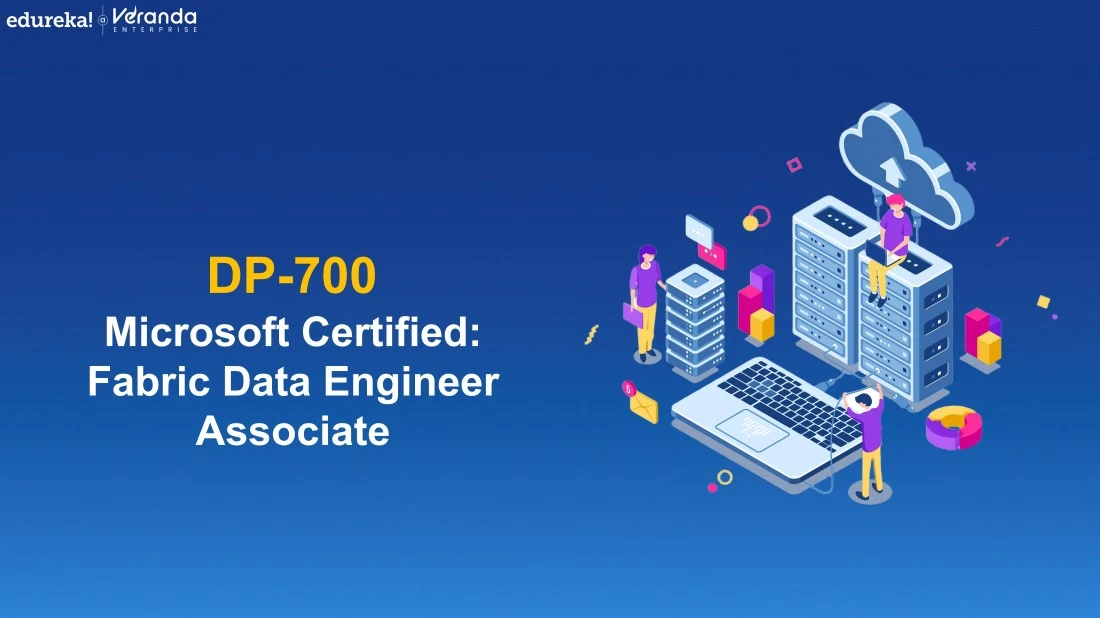Full Stack Development Internship Program
- 29k Enrolled Learners
- Weekend/Weekday
- Live Class
Microsoft Fabric has become a key platform in the quickly changing field of data engineering, providing extensive tools for data integration, transformation, and analysis. “Microsoft Fabric Data Engineer Associate ” is the official title of the DP-700, which is intended to verify professionals’ proficiency in using Microsoft Fabric to create reliable data solutions. This blog covers in-depth information about the DP-700 exam’s structure, the essential skills evaluated, study techniques, and the advantages of earning this certification.

Officially titled “Implementing Data Engineering Solutions Using Microsoft Fabric”, this assessment evaluates a candidate’s ability to design and implement data engineering solutions using Microsoft Fabric. It validates expertise in data ingestion, transformation, security, and optimization within the Fabric ecosystem.
Following that, we will examine the Microsoft Fabric Data Engineer Associate Microsoft Fabric Data Engineer Associate
This professional credential verifies your proficiency in implementing data engineering solutions using Microsoft’s unified analytics platform. It targets data professionals skilled in integrating, transforming, and combining structured and unstructured data into formats suitable for analytics solutions.
The exam assesses your ability to work with technologies like Power BI, Data Factory, Synapse, and OneLake, all integrated within Microsoft Fabric. A certified Fabric Data Engineer is expected to manage end-to-end pipelines, ensure performance, apply data security, and collaborate with stakeholders to deliver scalable analytics systems.
Achieving success in this certification requires practical, hands-on experience in building data engineering solutions. The key competencies include:
Designing and implementing data ingestion and transformation pipelines
Enforcing data governance and security
Monitoring and optimizing system performance
Collaborating with cross-functional teams for business intelligence solutions
Implement and manage an Analytics Solution (30–35%)
Setting Up Workspace Configuration for Microsoft Fabric
All of the data engineering resources, including pipelines, notebooks, reports, and lakehouses, are arranged in a Microsoft Fabric workspace.
You must understand how to:
Putting Security Measures in Place and Controlling Access
Workspace governance, access control, and data protection are all included in Microsoft Fabric security.
Important tasks include:
Become a CERTIFIED Microsoft Data Engineer with DP-700
Developing and Deploying Data Pipelines and Workflows
You will be evaluated based on your capacity to:
Ingest and Transform Data (35–40%)
Data Ingestion from Multiple Sources Microsoft Fabric is compatible with a large number of data sources, such as:
You need to know how to use pipelines, Dataflows Gen2, and connection setup in order to ingest data into Lakehouses or KQL databases.
Data Transformation Through the Use of Tools Like Notebooks and Dataflows
In order to prepare clean, usable data for analytics, data transformation is essential.
You ought to be proficient in:
Implementing Data Quality Checks and Validation Processes
Ensuring data consistency and accuracy is crucial.
Among the duties are:
Monitor and optimize an Analytics Solution (25–30%)
System performance and data pipeline monitoring guarantee the stability of your solution.
You will be assessed based on:
Optimizing Data Storage and Query Performance
Improving Query Performance and Data Storage Optimization is essential for cost and performance management.
Among the methods are:
Implementing Logging and Alerting Mechanisms
Error detection must be proactive.
You must:
Going on to the Exam Details
Question Formats:
Preparation Tip:
Exam Duration:
Exam Delivery:
Exam Fee:
The topic of how to prepare for the DP-700 exam will be covered next.
Exam Guide Review: Start by reviewing the official exam guide to understand the topics covered.
Use Microsoft Learn: Take advantage of the free learning paths and modules tailored for this role on Microsoft Learn.
Hands-on Labs: Gain practical experience with Microsoft Fabric components through interactive labs.
Join Study Groups: Participate in forums and online study groups to ask questions and share knowledge.
Practice Exams: Familiarize yourself with the format and question styles by taking practice tests.
Later, we’ll explore the key topics and workloads included in the Microsoft Fabric Data Engineer Associate path.
Data Storage Solutions: Design and implement scalable storage strategies and ensure data quality.
Data Warehousing: Focus on partitioning, storage optimization, and managing warehouses efficiently.
Data Factory: Automate workflows and manage data movement across multiple sources.
Business Intelligence: Develop reporting systems and optimized data models to drive insights.
Managing Microsoft Fabric workspaces
Implementing data ingestion and transformation processes
Enforcing data security and compliance
Monitoring and optimizing data solutions
Validating and ensuring data quality
Utilizing tools like Power BI, Synapse, and Data Factory
Achieving this credential validates your skills in data engineering within Microsoft Fabric. It demonstrates your ability to build scalable, secure data solutions—making you a valuable asset to organizations leveraging Microsoft’s data platform.
In this blog post, we dive into everything you need to know about the exam and the Microsoft Fabric Data Engineering path for 2025. From key skills like data ingestion, transformation, and analytics optimization to understanding the exam structure and preparation tips, this guide covers it all. Whether you’re starting your data engineering journey or aiming to validate your expertise, this qualification offers a streamlined path to mastering Microsoft Fabric’s powerful end-to-end data platform.
If you’re looking to upskill in Microsoft Fabric and build a strong foundation in modern data engineering, Edureka’s Microsoft Fabric Data Engineer Associate Training (DP-700) is a great place to start. This course covers everything from working with OneLake and Lakehouse architecture to building data pipelines, managing workloads, and optimizing performance in Fabric. With hands-on labs, real-world scenarios, and guidance aligned with the official DP-700 certification, this program helps you gain the expertise needed for high-demand roles in data engineering and analytics.
Do you have any questions or need further information? Feel free to leave a comment below, and we’ll respond as soon as possible!